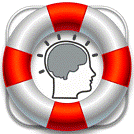Diagnosis is a shorthand that describes a cluster of symptoms that help providers more easily communicate, and gives them a starting point for identifying which symptoms you may be experiencing and what is causing them. The flu is a physical diagnosis. If you tell your doctor you think you have the flu, she will ask whether you have had a high fever, nausea, muscle aches, fatigue or loss of appetite. There are many different issues that can cause each symptom individually, but when they present together, it is a good bet that you have the flu. Depression and anxiety are the same way. Sleeping problems, fatigue, difficulty concentrating, irritability, and general loss of pleasure or apathy can all be symptoms of a variety of neurochemical or hormone imbalances. When all (or most) of them occur together we refer to it as “depression.” From there, it is a matter of exploring what is causing you to feel the symptoms you are experiencing. Neurochemical imbalances, nutritional deficits, physical exhaustion, illness (Chronic fatigue, chronic pain) and thyroid or hormone imbalances can all cause these symptoms.
Diagnosis certainly has its drawbacks. The most obvious is the stigma associated with having a “mental disorder.” Stigma is not unique to mental health diagnoses though. Many medical conditions that are complex to identify and/or treat also can result in stigma and loss of certain rights and privileges. Epilepsy, diabetes, lupus, Parkinson’s disease and fibromyalgia all come to mind. Like mental health issues, they are not contagious. In most cases, reasonably simple interventions can help a person live a perfectly normal life. Yet, in some cases these diagnoses prevent people from being able to get certain jobs and can be used against them socially and in legal proceedings by those who want that leverage. Many police departments still discriminate against people who take medication for depression. The military says they do not hold it against a soldier for trying to get help, but reality, in many cases I know of, still proves this to be untrue.
Personification is another drawback to diagnosis. When you have the flu, you don’t say I am the flu. You say I have the flu. Something you have is something you can get rid of. Something you are is a part of you and more enduring. When you have identified as being “depressed” or an “addict” for a period of time. It becomes part of you like being a “student” or a “mother” Letting go of that role involves adjusting to a new “self” and grieving the loss of that part of you. “If I am not an addict anymore, what am I” (lots of pressure there)
As I said earlier, most symptoms are common in multiple disorders (physical and mental). Take a minute and for each of the symptoms below, identify three times in the past when you have had that symptoms and hypothesize about what caused it and what you did to address it.
- Sleep Disturbances (sleeping too much, insomnia or waking up in the middle of the night)
- Eating Disturbances (lack of appetite, emotional eating, ravenous hunger)
- Difficulty Concentrating
- Racing Thoughts
- Fatigue (Not necessarily sleepiness, but lack of energy, or your body feeling super heavy and difficult to move)
- General achiness
When I work with people I will ask them about symptoms, but I try to stay away from diagnostic labels right away. They may have depressive symptoms because of hypothyroid or lyme disease. I feel that if I start telling them they have depression, then their focus may turn to addressing it only cognitively/emotionally, or by seeking out psychotropic medication which may, or may not, help. While most people have some cognitive stuff that they can address, it is vital to evaluate the functioning of the whole system, not just the mind. Sometimes treating depressive symptoms is as simple as addressing whatever is causing the sleep disorder such as hypothyroid, apnea or chronic pain.
The final drawback is that when we adhere strictly to diagnostic criteria, some people fall through the cracks. What happens when people only meet 4 of 5 criteria? Or, what happens when people to narrowly define diagnostic criteria like “sleep problems.” The answer is, they do not meet the criteria for a diagnosis and the presenting symptoms they do have are often minimized; therefore, people often do not seek help until they nicely “fit” a diagnosis. Prevention is far more effective and efficient than treatment. How much faster could someone start feeling better if they got treatment at the first sign of depressive symptoms? When people wait until they just cannot deal with it anymore, problems in relationships, mood, work etc. have continued to get worse which is making the mood disorder or addiction worse. In this scenario, people not only have to deal with their symptoms, but also the effects their symptoms have had in all areas of their life.
Diagnosis is a necessary evil. It provides a starting place for exploring a cluster of symptoms, but it is vital to remember that it is part art and part science. These symptoms are the body’s way of indicating something is wonky. People can greatly help themselves and their care team by understanding (and communicating) their symptoms and what makes them worse and better.
